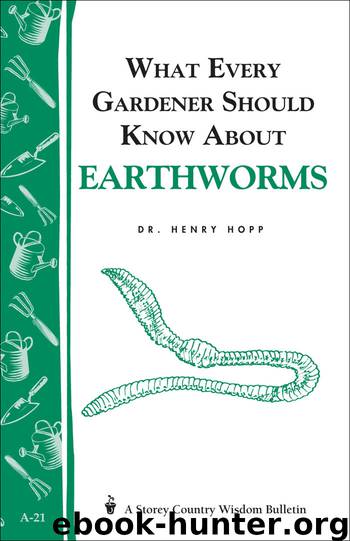What Every Gardener Should Know About Earthworms by Henry Hopp

Author:Henry Hopp
Language: eng
Format: epub
Publisher: Storey Publishing, LLC
Published: 2008-03-25T16:00:00+00:00
Building Worm Population
Earthworms are very sensitive to changes in the soil brought about by cropping the land. In localities where earthworms are present, the population varies greatly according to the farming or gardening methods used.
Recent investigations have disclosed efficient methods of maintaining earthworms on tilled land. These new practices came from studies on the life habits of earthworms.
It was found that earthworms follow a well-defined yearly cycle. One might consider the cycle as starting in the fall of the year (below). At that time, many of the earthworms are young, just starting their life. With the advent of wet, cool weather, they become extremely active physically. They feed on the organic debris in and on top of the soil, and mix it with the mineral soil to produce casts, as well as making new burrows in the soil. During damp, cool nights, and occasionally on wet cloudy days, too, they come out of their burrows to seek new areas to inhabit. Within a few hours of a night, they may migrate a considerable number of feet. With dawn, they disappear into the ground but the tracks they leave in the soft ground are evidence of their nocturnal meanderings.
The high level of physical activity normally continues throughout the fall, winter and spring. During this period, the young earthworms mature and more eggs are laid. During the winter, both mature and young earthworms, as well as eggs, can be found in the soil. But by late spring, most of the earthworms are mature. With the coming of summer, the soil dries and heats. The earthworms become less and less active. They lay eggs and many die. During the hottest and driest part of the summer, almost all the earthworms in a garden are young ones or unhatched eggs that had been deposited by the mature ones before they died.
Download
This site does not store any files on its server. We only index and link to content provided by other sites. Please contact the content providers to delete copyright contents if any and email us, we'll remove relevant links or contents immediately.
| Anatomy | Animals |
| Bacteriology | Biochemistry |
| Bioelectricity | Bioinformatics |
| Biology | Biophysics |
| Biotechnology | Botany |
| Ecology | Genetics |
| Paleontology | Plants |
| Taxonomic Classification | Zoology |
Sapiens: A Brief History of Humankind by Yuval Noah Harari(14256)
The Tidewater Tales by John Barth(12609)
Mastermind: How to Think Like Sherlock Holmes by Maria Konnikova(7231)
Do No Harm Stories of Life, Death and Brain Surgery by Henry Marsh(6891)
The Thirst by Nesbo Jo(6832)
Why We Sleep: Unlocking the Power of Sleep and Dreams by Matthew Walker(6620)
Life 3.0: Being Human in the Age of Artificial Intelligence by Tegmark Max(5478)
Sapiens by Yuval Noah Harari(5295)
The Longevity Diet by Valter Longo(5021)
The Body: A Guide for Occupants by Bill Bryson(4976)
The Rules Do Not Apply by Ariel Levy(4866)
The Immortal Life of Henrietta Lacks by Rebecca Skloot(4528)
Animal Frequency by Melissa Alvarez(4399)
Why We Sleep by Matthew Walker(4362)
The Hacking of the American Mind by Robert H. Lustig(4319)
Yoga Anatomy by Kaminoff Leslie(4309)
All Creatures Great and Small by James Herriot(4233)
Double Down (Diary of a Wimpy Kid Book 11) by Jeff Kinney(4208)
Embedded Programming with Modern C++ Cookbook by Igor Viarheichyk(4105)
